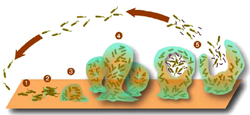New Study Reveals Ozone’s Hidden Toll on America’s Trees
A new nationwide study reveals that ozone pollution—an invisible threat in the air—may be quietly reducing the survival chances of many tree species across the United States. The research, published in the Journal of Geophysical Research: Atmospheres is the first…


 When planktonic or swimming bacterial microorganisms attach themselves to a surface, they secrete polysaccharides, creating a matrix of slimy polymers. There are numerous types of biofilms that are created by different phenotypes of bacteria. One bacterial type is responsible for the plaque that builds up on teeth, while another type builds up on the surface of Navy vessels, which creates additional drag and power loss as they sail through the seas. Bacteria can also colonize in arteries and lungs, leading to life-threatening infections. Biofilms are extremely resistant to antibiotics, as compared to planktonic bacteria.
When planktonic or swimming bacterial microorganisms attach themselves to a surface, they secrete polysaccharides, creating a matrix of slimy polymers. There are numerous types of biofilms that are created by different phenotypes of bacteria. One bacterial type is responsible for the plaque that builds up on teeth, while another type builds up on the surface of Navy vessels, which creates additional drag and power loss as they sail through the seas. Bacteria can also colonize in arteries and lungs, leading to life-threatening infections. Biofilms are extremely resistant to antibiotics, as compared to planktonic bacteria.